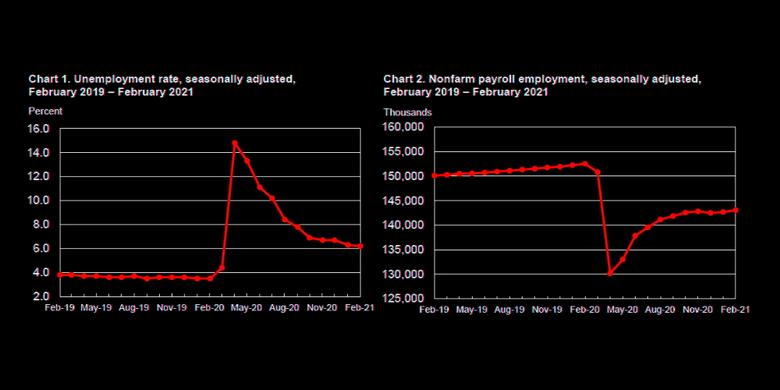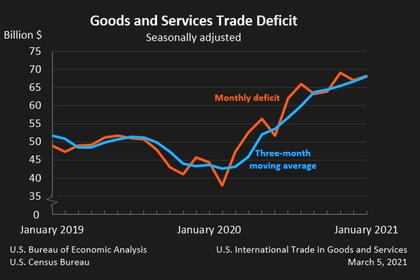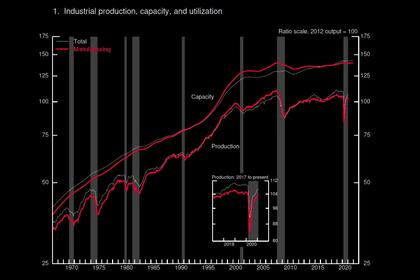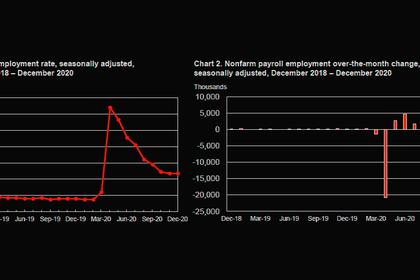
U.S. EMPLOYMENT UP

U.S. BLS - Friday, March 5, 2021 - THE EMPLOYMENT SITUATION -- FEBRUARY 2021
Total nonfarm payroll employment rose by 379,000 in February, and the unemployment rate was little changed at 6.2 percent, the U.S. Bureau of Labor Statistics reported today.
The labor market continued to reflect the impact of the coronavirus (COVID-19) pandemic.
In February, most of the job gains occurred in leisure and hospitality, with smaller gains in temporary help services, health care and social assistance, retail trade, and manufacturing. Employment declined in state and local government education, construction, and mining.
This news release presents statistics from two monthly surveys. The household survey measures labor force status, including unemployment, by demographic characteristics. The establishment survey measures nonfarm employment, hours, and earnings by industry. For more information about the concepts and statistical methodology used in these two surveys, see the Technical Note.
Household Survey Data
Both the unemployment rate, at 6.2 percent, and the number of unemployed persons, at 10.0 million, changed little in February. Although both measures are much lower than their April 2020 highs, they remain well above their pre-pandemic levels in February 2020 (3.5 percent and 5.7 million, respectively). (See table A-1. See the box note at the end of this news release for more information about how the household survey and its measures were affected by the coronavirus pandemic.)
Among the major worker groups, the unemployment rate for Asians declined to 5.1 percent in February. The rates for adult men (6.0 percent), adult women (5.9 percent), teenagers (13.9 percent), Whites (5.6 percent), Blacks (9.9 percent), and Hispanics (8.5 percent) showed little or no change. (See tables A-1, A-2, and A-3.)
Among the unemployed, the number of persons on temporary layoff fell by 517,000 in February to 2.2 million. This measure is 1.5 million higher than the level a year earlier but is down considerably from the recent high of 18.0 million in April 2020. The number of permanent job losers, at 3.5 million, was essentially unchanged in February but is 2.2 million higher than a year earlier. (See table A-11.)
The number of long-term unemployed (those jobless for 27 weeks or more), at 4.1 million, changed little over the month but is up by 3.0 million over the year. In February, these long-term unemployed accounted for 41.5 percent of the total unemployed. The number of persons jobless less than 5 weeks, at 2.2 million, also changed little over the month. (See table A-12.)
The labor force participation rate remained at 61.4 percent in February. This measure is 1.9 percentage points lower than the value a year earlier. The employment-population ratio, at 57.6 percent, changed little over the month but is down by 3.5 percentage points over the year. (See table A-1.)
The number of persons employed part time for economic reasons, at 6.1 million, changed little in February but is up by 1.7 million over the year. These individuals, who would have preferred full-time employment, were working part time because their hours had been reduced or they were unable to find full-time jobs. (See table A-8.)
In February, the number of persons not in the labor force who currently want a job was 6.9 million, little changed over the month but up by 1.9 million over the year. These individuals were not counted as unemployed because they were not actively looking for work during the last 4 weeks or were unavailable to take a job. (See table A-1.)
Among those not in the labor force who currently want a job, the number of persons marginally attached to the labor force, at 1.9 million, was essentially unchanged in February but is up by 453,000 over the year. These individuals wanted and were available for work and had looked for a job sometime in the prior 12 months but had not looked for work in the 4 weeks preceding the survey. The number of discouraged workers, a subset of the marginally attached who believed that no jobs were available for them, was 522,000 in February, little changed from the previous month but up by 121,000 over the year. (See Summary table A.)
Household Survey Supplemental Data
In February, 22.7 percent of employed persons teleworked because of the coronavirus pandemic, down from 23.2 percent in January. These data refer to employed persons who teleworked or worked at home for pay at some point in the last 4 weeks specifically because of the pandemic.
In February, 13.3 million persons reported that they had been unable to work because their employer closed or lost business due to the pandemic--that is, they did not work at all or worked fewer hours at some point in the last 4 weeks due to the pandemic.
This measure is down from 14.8 million in January. Among those who reported in February that they were unable to work because of pandemic-related closures or lost business, 10.5 percent received at least some pay from their employer for the hours not worked, down from 12.7 percent in January.
Among those not in the labor force in February, 4.2 million persons were prevented from looking for work due to the pandemic. This measure is down from 4.7 million in January. (To be counted as unemployed, by definition, individuals must be either actively looking for work or on temporary layoff.)
These supplemental data come from questions added to the household survey beginning in May 2020 to help gauge the effects of the pandemic on the labor market. The data are not seasonally adjusted. Tables with estimates from the supplemental questions for all months are available online at www.bls.gov/cps/effects-of-the-coronavirus-covid-19-pandemic.htm.
Establishment Survey Data
Total nonfarm payroll employment increased by 379,000 in February but is down by 9.5 million, or 6.2 percent, from its pre-pandemic level in February 2020. In February of this year, most of the job gains occurred in leisure and hospitality, with smaller gains in temporary help services, health care and social assistance, retail trade, and manufacturing. Employment declined in state and local government education, construction, and mining. (See table B-1. See the box note at the end of this news release for more information about how the establishment survey and its measures were affected by the coronavirus pandemic.)
In February, employment in leisure and hospitality increased by 355,000, as pandemic- related restrictions eased in some parts of the country. About four-fifths of the increase was in food services and drinking places (+286,000). Employment also rose in accommodation (+36,000) and in amusements, gambling, and recreation (+33,000). Employment in leisure and hospitality is down over the year by 3.5 million, or 20.4 percent.
Within professional and business services, temporary help services added 53,000 jobs in February but is down by 175,000 from a year ago. Employment in health care and social assistance increased by 46,000 in February. Health care employment was little changed over the month (+20,000), following a large decline in the prior month (-85,000). In February, job gains in ambulatory health care services (+29,000) were partially offset by losses in nursing care facilities (-12,000).
Employment in social assistance rose by 26,000, mostly in individual and family services (+18,000). Employment in health care and social assistance is down by 909,000 over the year.
Retail trade added 41,000 jobs in February. Job growth was widespread in the industry, with the largest gains occurring in general merchandise stores (+14,000), health and personal care stores (+12,000), and food and beverage stores (+10,000). These gains were partially offset by a loss in clothing and clothing accessories stores (-20,000).
Following steep job losses in March and April of 2020 (-2.4 million jobs over the 2 months combined), retail trade has added 2.0 million jobs from May through February. Manufacturing employment increased by 21,000 over the month, led by a gain in transportation equipment (+10,000). Employment in manufacturing is down by 561,000 over the year.
In February, employment declined in local government education (-37,000) and state government education (-32,000). For both industries, February losses partially offset gains in January. Pandemic-related employment declines in 2020 distorted the normal seasonal buildup and layoff patterns in the education sector, making it more challenging to discern the current employment trends in these industries.
Employment in construction fell by 61,000 in February, largely reflecting declines in nonresidential specialty trade contractors (-37,000) and heavy and civil engineering construction (-21,000). Severe winter weather across much of the country may have held down employment in construction. Employment in the industry is 308,000 below its level a year earlier.
Mining shed 8,000 jobs in February, with losses occurring in support activities for mining (-6,000) and in oil and gas extraction (-2,000). Mining has lost 153,000 jobs since an employment peak in January 2019, though nearly two-thirds of the loss has occurred over the past year.
In February, employment changed little in other major industries, including wholesale trade, transportation and warehousing, information, financial activities, and other services.
In February, average hourly earnings for all employees on private nonfarm payrolls increased by 7 cents to $30.01. Average hourly earnings for private-sector production and nonsupervisory employees, at $25.19, changed little (+4 cents). The large employment fluctuations over the past year--especially in industries with lower-paid workers-- complicate the analysis of recent trends in average hourly earnings. (See tables B-3 and B-8.)
The average workweek for all employees on private nonfarm payrolls declined by 0.3 hour to 34.6 hours in February. In manufacturing, the workweek declined by 0.2 hour to 40.2 hours, and overtime declined by 0.1 hour to 3.1 hours. The average workweek for production and nonsupervisory employees on private nonfarm payrolls declined by 0.4 hour to 34.0 hours. (See tables B-2 and B-7.)
The change in total nonfarm payroll employment for December was revised down by 79,000, from -227,000 to -306,000, and the change for January was revised up by 117,000, from +49,000 to +166,000. With these revisions, employment in December and January combined was 38,000 higher than previously reported. (Monthly revisions result from additional reports received from businesses and government agencies since the last published estimates and from the recalculation of seasonal factors.)
-----
Earlier:

















